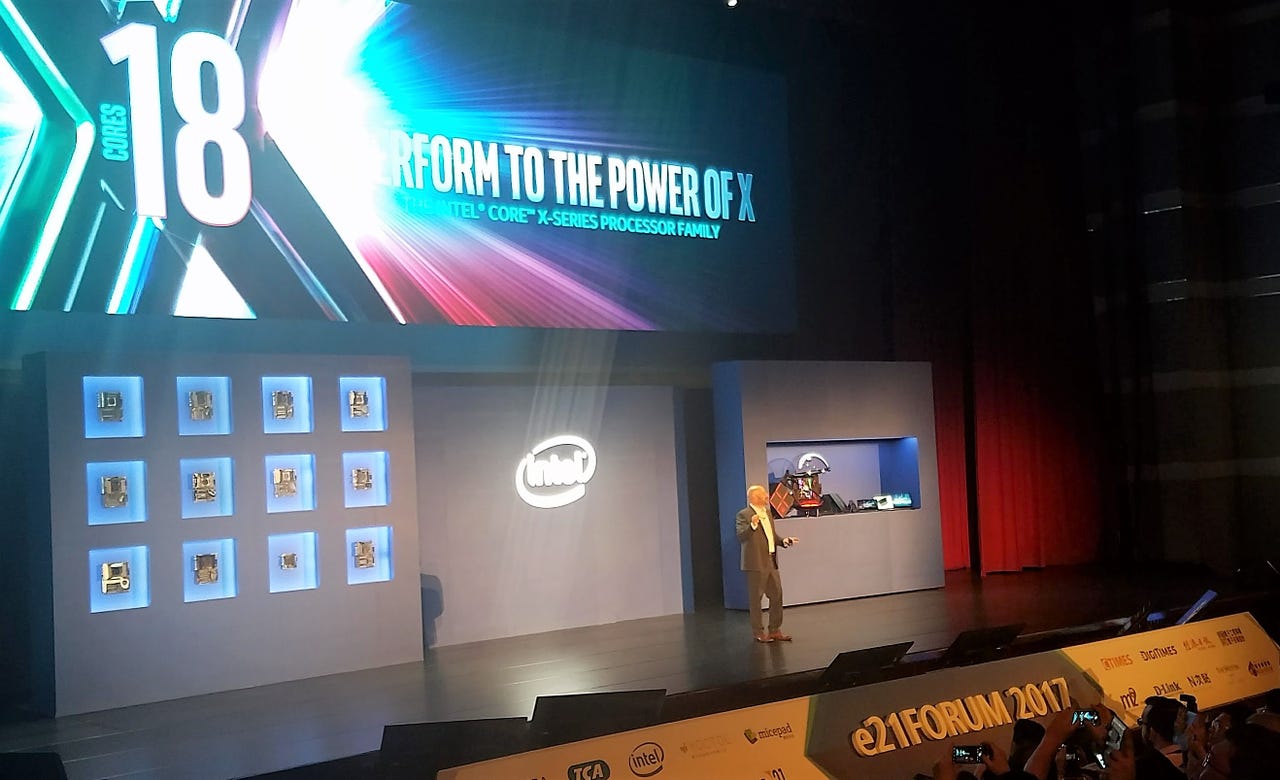Computex 2017: Intel rediscovers the desktop


In recent years Intel has used Computex to try to shake up the laptop market. The chipmaker announced the Ultrabook and later coined the term 2-in-1 here in Taiwan, and more recently it has been pushing concepts such as true wireless computing.
Not all of these initiatives have worked but Intel and its partners have certainly succeeded in making laptops notably thinner, lighter and more attractive (some of these were on display during today's opening keynote). This hasn't been enough, however, to reverse the long slide in the overall PC market.
One rare bright spot has been the high-end systems for gaming, virtual reality and content creation. Intel says sales of its unlocked desktop processors have been growing 20 percent year-on-year. So perhaps it's no surprise that this year it has turned its attention to that market with the announcement of several new products including the world's first 18-core desktop chip. "It's the best of the best," said Intel's Gregory Bryant, the head of the Client Computing Group, in his keynote.
The announcement of the new X-Series, which will be sold under the Core i5, Core i7 and new Core i9 brands, had been widely rumored. But the surprise was that it would scale all the way from a $242 Core i5-7640X with four cores (eight threads) to a $2,000 Core i9-7980XE Extreme Edition with a whopping 18 cores and 36 threads. Intel described it as the first CPU capable of 1 teraflop, or one trillion floating-point operations per second. Altogether the launch includes nine chips with six-, eight-, 10-, 12-, 14- and 16-core variants in the middle.
These Skylake-X processors are a replacement for the Broadwell-E line that currently tops out with Core i7-6950X Extreme Edition, which has 10 cores and carries a list price of a little more than $1,700. The new Core i9-7900X, also with 10 cores, will be priced at $1,000. In a core-for-core comparison of these two chips, Intel said the new i9-7900X will deliver 10 percent better multi-threaded performance and a 15 percent boost on single-threaded applications. One reason for this is an enhanced version of Turbo Boost that improves performance when primarily using one or two cores.
Also: Intel unveils monster 18-core Core i9: 'First teraflop-speed' consumer PC chip | Composable infrastructure: The Next Big Thing in datacenters | Intel Core i9: It's not whether you need 12 cores, but whether you'll pay for them | Computex 2017: ARM has designs on more than mobile
That's in part because the real-world applications of this many cores are very limited. During the presentation, Intel demonstrated VR gaming while simultaneously streaming in 4K on Twitch and Unity's Ralph Hauwert talked about creating games in VR and changing the lighting in a scene more quickly. These are niche use cases, but Skylake-X is also a response to AMD's new Ryzen 7, with up to 8 cores (16 threads) and especially the colorfully-named Threadripper, with up to 16 cores (32 threads) that AMD is expected to discuss in more detail at a press conference tomorrow.
On stage, Intel was showing several motherboards based on the new X299 chipset for Skylake-X as well as HP Omen and Lenovo Legion gaming rigs. Intel was also showing several products based on its new Kaby Lake Core i7 H-Series quad-core processors including Acer Trident 700, Asus ROG Zephyrus and Lenovo Yoga 720 laptops, and an MSI Vortex VR-ready backpack PC. The more interesting demonstrations included a wireless HTV Vive VR headset using 60GHz WiGig and an Intel Compute Card with onboard CPU, storage and connectivity that plugs in to a small desktop or all-in-one.
The other big surprise is that Intel is expecting to get a big performance boost out of Coffee Lake, the next generation of Core processors based on an enhanced process called 14nm++. The company now says that the 8th-Generation Core processors will deliver 30 percent better performance than Kaby Lake, but as usual the devil's in the details, and this comparison of a current Core i7-7500U dual-core to a Coffee Lake quad-core with a much higher Turbo Boost ceiling is raising more questions than it answers. For now, Intel is simply stating that Coffee Lake desktops and laptops will be available in time for the holidays.
Intel by no means neglected laptops and 2-in-1s, highlighting some especially thin designs including the Huawei MateBook X and the ZenBook Flip S, which Asus announced at a packed press conference yesterday. The company also talked about the concept of the Always Connected PC and said some 30 partners are working on models including the Asus Kukuna 2-in-1 with a Core processor and built-in LTE. But overall this year's show belonged to powerful desktops where the competition is ramping up.